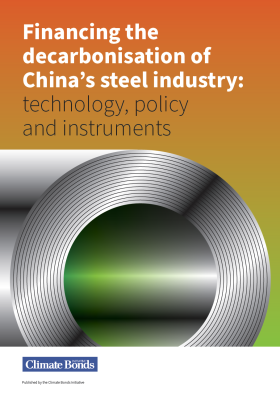This decade is pivotal for the transition of the steel sector towards the targets set out in the Paris Agreement. In China alone, 78% (730.8 Mt/yr) of the existing coal-based blast furnace capacity will need reinvestment by 2030, demonstrating the magnitude of investment needed to develop and roll out low-carbon steelmaking technologies to transform the sector. Financial flows must be aligned with a Paris-compatible scenario to avoid lock-in and be in place for the next investment cycle, given the longevity of steel assets.
To support this transition, Climate Bonds produced a new report outlining levers to accelerate the decarbonisation of the steel sector and describing how transition finance can supply the required capital. The report is also available in Chinese.
 Currently, zero-carbon steel is technically feasible but expensive. The steel sector in China requires fixed-asset investment estimated to be at least CNY1.6tn (USD220bn) for decarbonisation by 2050, the finance for which could be supplied by the sustainable debt market.
Currently, zero-carbon steel is technically feasible but expensive. The steel sector in China requires fixed-asset investment estimated to be at least CNY1.6tn (USD220bn) for decarbonisation by 2050, the finance for which could be supplied by the sustainable debt market.
China dominates the global steel production industry, accounting for 53% of the world’s total capacity and 15% of the country’s total carbon emissions. 78% of China’s steel assets will need to be retired or require refinancing by 2030, presenting a low-carbon investment opportunity and a critical window to mobilise capital for transition.
Investors’ appetite to support credible issuance is strong. In the context of China’s 30:60 climate targets (peak carbon emissions by 2030 and carbon neutrality by 2060) and rising carbon prices, steel companies need to strengthen emission management and take action towards low-carbon transition. Steel issuers can refer to existing green and transition finance guidelines to access climate financing and accelerate corporate climate action.
Steel companies have started to act towards decarbonisation. The top three Chinese steel-producing companies (Baowu, Anstee, HBIS), representing 22% of China’s total production, have announced emission reduction targets and started to pilot hydrogen-based steel production.
How can the low-carbon steel transition be financed?
China was the world’s largest green bond market for the second consecutive year. As of the end of 2023, a total of CNY4.46tn (USD616.2bn) of labelled green bonds had originated from China in domestic and overseas markets, of which nearly CNY2.7tn (USD372bn) meet Climate Bonds’ green definitions.
Despite the continuous expansion of the Chinese labelled bond market, only 0.1% has originated from issuers in the steel sector. Compared to the progress towards low-carbon transition (estimated at least CNY1.6tn), the current issuance volume from the Chinese steel sector is very small. The labelled bond and loan market can supply the required capital but issuers operating in the steel sector must be encouraged to price deals with the recommended transparency and credibility.
Policymakers are increasingly developing transition finance frameworks and steel criteria in China
Regulators and financial institutions are developing guidelines and standards to promote the orderly development of China’s transition finance market. Several provinces in China have issued provincial-level transition finance guidance, including the major steel-producing province, Hebei, which issued steel sector-specific transition finance guidance in 2024.
Both domestically and internationally, major banks have also released transition finance frameworks that include sectoral criteria for the steel sector, opening channels for steel companies to access climate financing.
Looking forward, regulators and financial institutions must further incentivise steel companies to accelerate the deployment of low-carbon production. A coordinated effort between industry, policymakers, investors, and civil society is necessary to incentivise the steel sector through increased understanding and use of trusted tools, such as the Climate Bonds Steel Criteria.
‘Til next time,
Climate Bonds

